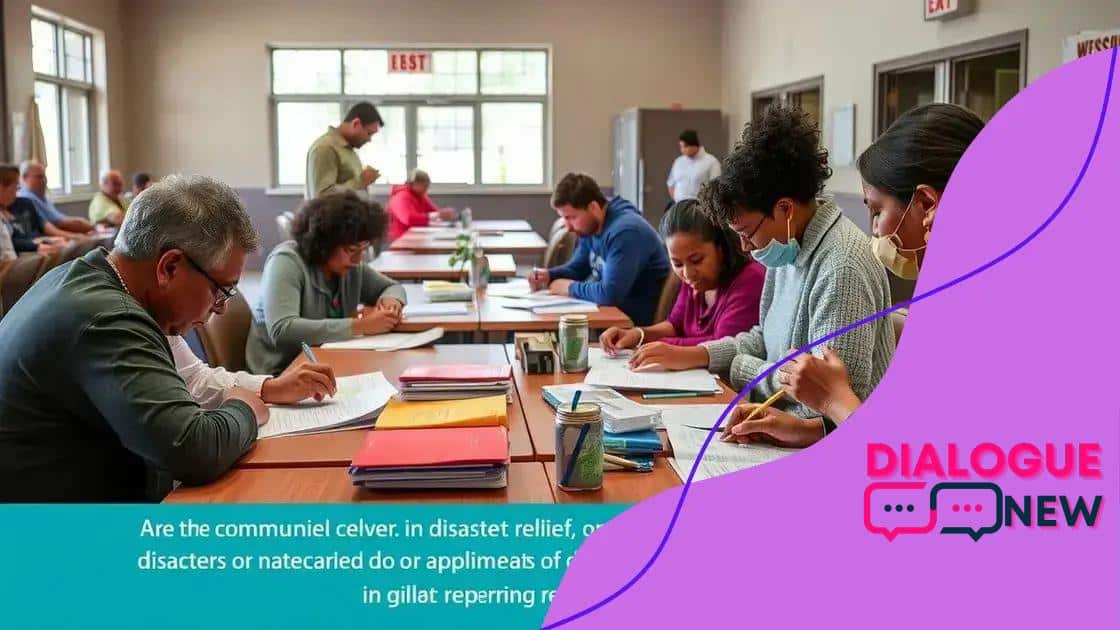Emergency financial relief programs for disaster recovery

Emergency financial relief programs offer crucial assistance to individuals and communities affected by disasters, providing funds for recovery and rebuilding after crises.
Emergency financial relief programs for disaster recovery play a vital role in helping communities get back on their feet. Have you ever wondered how these programs work and who they help? Let’s dive into the details.
Understanding emergency financial relief programs
Understanding emergency financial relief programs is essential for those affected by disasters. These programs are designed to provide immediate assistance to individuals and families during challenging times. They can significantly impact a community’s recovery by offering support when it’s needed most.
What Are Emergency Financial Relief Programs?
Emergency financial relief programs are initiatives set up by various organizations, including government agencies and non-profit groups. These programs focus on assisting those impacted by disasters, such as natural calamities or unexpected crises.
Key Features of These Programs
- Quick Assistance: Relief funds are often distributed quickly to help people rebuild their lives.
- Broad Coverage: Many programs cover various expenses, including housing, healthcare, and essential daily needs.
- No Repayment Required: Most aid provided through these programs does not need to be paid back.
Many people wonder how to qualify for these resources. Generally, applicants must demonstrate a financial need caused by the disaster and provide necessary documentation. Understanding the eligibility criteria can help streamline the application process.
Who Is Eligible?
Eligibility can vary based on the type of relief program. However, common criteria often include:
- Residents of the affected areas
- Verification of the disaster’s impact
- Proof of income or financial hardship
Each program may have its own specific requirements, so it’s important to check with the relevant agency before applying.
In the aftermath of a disaster, communities often rely on these programs to support recovery efforts. They not only provide financial aid but also help foster resilience among individuals and families. Programs are important for restoring not just physical structures, but also the emotional well-being of those impacted.
Types of disaster relief available
There are various types of disaster relief available to support individuals and families in need. These programs aim to alleviate the financial burden caused by unexpected disasters and help communities rebuild.
Government Assistance Programs
Federal and state governments often establish assistance programs after major disasters. These programs may include:
- Federal Disaster Assistance: Available through FEMA, providing funds for temporary housing and home repairs.
- State Relief Funds: State governments may have specific programs tailored to local needs.
Eligibility for these programs typically depends on the level of damage and the applicant’s financial situation.
Non-Profit Organizations
Many non-profit organizations play a vital role in delivering aid. These groups often provide:
- Financial Grants: Direct cash assistance to individuals affected by disasters.
- Food and Shelter: Immediate support in the form of meals and accommodation.
- Emotional Support Services: Counseling and mental health services to help individuals cope.
Non-profits can be crucial in filling the gaps left by government programs, offering personalized assistance and resources.
Insurance Claims
In many cases, individuals may file claims with their insurance companies for relief. Understanding policy details is essential. Coverage can vary based on:
- Type of Disaster: Different events may be covered under various policies.
- Extent of Damage: Only certain levels of damage might be eligible for claims.
Filing claims promptly and accurately is important for receiving the necessary assistance. Knowing what to expect can ease the stress of the recovery process.
Each type of relief program has its own application process and requirements. It can feel overwhelming to navigate these options, but finding the right assistance can make a significant difference.
Eligibility requirements for applicants

Understanding the eligibility requirements for applicants of disaster relief programs is crucial for those seeking aid. Each program has specific criteria that applicants must meet before they can receive assistance.
Common Eligibility Criteria
Most disaster relief programs consider several key factors. These typically include:
- Location: Applicants must generally reside in the disaster-affected area.
- Financial Need: Evidence of financial hardship caused by the disaster is often required.
- Documented Loss: Applicants may have to provide proof of damage or loss due to the disaster.
These factors help organizations determine who is most in need of assistance, ensuring aid goes to those who require it the most.
Types of Documentation Required
When applying for assistance, individuals need to gather specific documents to support their applications. This may include:
- Proof of Identity: Such as a driver’s license or government-issued ID.
- Income Verification: Recent pay stubs or tax returns.
- Damage Assessment Reports: Assessments from local authorities or insurance companies detailing the extent of the loss.
Having this documentation ready can speed up the application process, making it easier to qualify for aid.
Different relief programs may have additional requirements, so it’s essential to check the specific guidelines for each program. Applicants should also be prepared for interviews or follow-up questions. Being honest and clear about their situation helps ensure a smoother application experience.
How to apply for financial assistance
Applying for financial assistance through disaster relief programs can seem overwhelming, but it doesn’t have to be. Understanding the steps involved will help make the process smoother and more efficient.
Gather Required Documents
Before starting the application, gather all necessary documents. This includes:
- Identification: Government-issued IDs or driver’s licenses to prove identity.
- Proof of Residence: Utility bills or lease agreements showing your address.
- Income Information: Recent pay stubs or tax returns to demonstrate financial need.
Having these documents ready can significantly speed up the application process.
Visit the Appropriate Office or Website
Next, you should find the right place to apply. You can often apply online for many programs, which makes it easy to submit your information securely. Local offices may also be available for in-person applications. Make sure to:
- Check official websites: Look for the disaster relief programs offered by your state or federal government.
- Contact local organizations: Non-profits are often ready to help you apply and guide you through the process.
It’s important to ensure you are accessing the correct resources, as many help programs are specific to certain disasters.
Complete the Application Accurately
When filling out the application, follow the instructions carefully. Provide accurate information and be thorough in detailing your situation. This will help prevent delays. Ensure that:
- All forms are filled out completely without missing information.
- You check for spelling and accuracy before submitting.
Once submitted, keep a copy of your application and any supporting documents for your records. This can be valuable if you need to follow up later. Remember to check back regarding the status of your application.
By understanding how to apply, you can access the assistance you need more easily. The process can take time, but knowing what to expect will help you feel more prepared and confident.
Success stories from disaster recovery efforts
Success stories from disaster recovery efforts highlight the resilience and strength of individuals and communities. These stories provide hope and inspiration for those navigating their recovery journey.
Real-Life Examples
Many communities have come together after disasters, showcasing remarkable recovery efforts. One notable case involved a small town devastated by a hurricane. Residents united to rebuild their homes and businesses. Their determination inspired surrounding areas to lend support and resources.
Lessons Learned
From these success stories, several important lessons emerge:
- Community Engagement: Active participation from community members can lead to faster recovery.
- Resource Sharing: Collaborating with local organizations creates a stronger support network.
- Emotional Resilience: Mental health support plays a vital role in recovery; sharing experiences can help.
These lessons remind us that support systems are critical in disaster recovery. Sharing success stories can uplift morale and motivate others facing similar challenges.
Case Studies of Effective Aid
Various organizations have played a significant role in successful recovery efforts. For instance, a non-profit organization stepped in after a devastating flood, providing immediate assistance and long-term support. They helped families with housing, food, and mental health services, leading to substantial recovery progress.
Many of these organizations not only provide resources but also guide survivors on how to navigate applying for assistance. Their tailored programs demonstrate the impact proper aid can have on recovery.
As we share these success stories, we see the strength behind communal efforts. They show that with aid, hope, and determination, recovery is possible. These narratives inspire ongoing resilience in the face of adversity.
FAQ – Frequently Asked Questions about Emergency Financial Relief Programs
What are emergency financial relief programs?
These programs provide immediate financial assistance to individuals and families affected by disasters, helping them recover and rebuild.
Who is eligible for financial assistance?
Eligibility typically requires proof of residence in the affected area and evidence of financial hardship due to the disaster.
How do I apply for disaster relief?
You can apply online or at local disaster relief centers. Gather necessary documents and follow the specific guidelines for the program.
Can I share my success story of recovery?
Yes! Sharing success stories can inspire others and help communities understand the impact of support and resilience.





